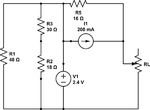husny540
Member level 1

- Joined
- Aug 4, 2013
- Messages
- 33
- Helped
- 0
- Reputation
- 0
- Reaction score
- 0
- Trophy points
- 6
- Activity points
- 301
Using the thevenin's equivalent circuit, plot the variation VL, IL, and PL when the load resistance is changed from 10 ohm to 3o ohm and hence dtermine the load resistance which recieves maximum power.
I found the thevenin voltage as 5.6V and Thevenin resistance as 16 ohm. Plese help me with the question i posted
I found the thevenin voltage as 5.6V and Thevenin resistance as 16 ohm. Plese help me with the question i posted
Attachments
Last edited:

